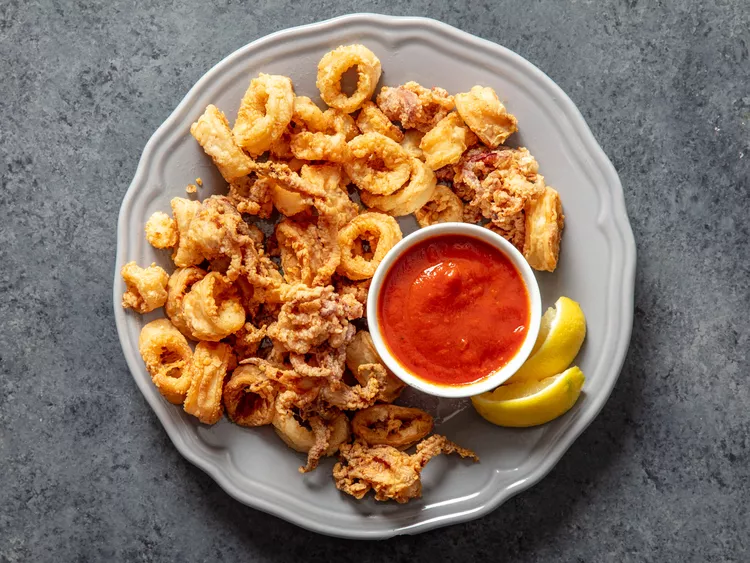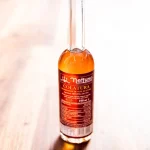Why it Works
The calamari will still be tender when you slice the squid into thicker rings. This allows the coating to crisp and brown properly.
The milk will help to mask fishy flavors and provide enough viscosity to allow the dredge a good grip on the meat.
The combination of cornstarch, wheat flour and baking powder produces a light, crisp exterior that is well-browned.
After dredging, allow the flour to fully hydrate for 15 minutes. This will ensure that the batter stays on the calamari.
Fried calamari is a dish that represents casual American cuisine. These crispy, juicy strips of squid make a great finger food to share with family.
Advertisement Banner
Fried calamari has only been added to American menus relatively recently. According to an analysis by The New York Times of food trends, calamari only became popular in America during the late 1970s. In an effort to reduce overfishing, federal and state marine conservation programs encouraged restaurants to include squid in their menus. You can get fried calamari almost anywhere today, including roadside clamshacks, bars and of course the Italian-American red sauce joints.
It’s easy to make fried calamari, even if you usually eat it at restaurants. The secret is in the details. Soak the squid, then give it a balanced dredging. After a short cooking time, you’ll get a golden crust with tender squid.
The milk and salt will help to neutralize any fishy flavor and season the meat. Milk’s slight viscosity helps the flour to adhere to the squid. *
Lactic acid is believed to be responsible for the tenderizing effects of marinating in dairy. This technique may be effective for other meats but I did not find that dairy produced any significant improvements in the texture.
To achieve a crispy, evenly browned outside, I use a mixture of wheat flour with cornstarch. The proteins in wheat flour help to brown the meat, while a little baking powder helps to aerate the coating. Cornstarch also keeps the dredge crispy and reduces grease. The exact proportion is up to personal taste. You can reduce the amount of cornstarch if you want to make the calamari less crisp (or leave it out entirely, the calamari are still delicious) or increase the amount if you prefer a crunchier shell. You can adjust the flour amount to get the same amount of dredge.
To ensure tender squid when frying, it is important to maintain a constant temperature. Cooking the squid only for a few moments will also yield a tasty result. To keep the temperature from dipping too low, the best approach is to start with the oil a bit hotter than you’ll really need (around 365degF/185degC) to so that it’ll drop into the ideal zone (around 275-300degF/135-150degC) once the squid is added. Use a thermometer to adjust the heat as needed.
Featured Videos
Recipe Facts
4.7
(3)
Active:
50 minutes
Total:
2 hrs
Serves:
Four servings
Rate and Comment
Ingredients
1/2 cup (120ml) milk
Diamond Crystal kosher Salt, 1 teaspoon (3g); for table salt, use half the volume or weight.
Clean 1 pound (454g), squids, bodies cut into rings of 3/4 inch thick, but tentacles are left intact.
1 3/4 cups (7 ounces; 200g) all-purpose flour
Cornstarch, 1 1/2 ounces (44g), 1/3 cup
Black pepper, freshly ground: 1/2 teaspoon
1/4 teaspoon baking powder
2 quarts (1.9L), neutral vegetable oil or another neutral oil
One recipe for Quick and Easy Italian American Red Sauce in less than 40 minutes (see note).
Lemon wedges for serving
Directions
Whisk together the milk and salt in a medium-sized bowl. Add the squid to the bowl and coat. Refrigerate squid at least for 30 minutes, but up to two hours.
Mix flour, cornstarch and baking powder in a large mixing bowl for 30 seconds. Set aside.
Place a wire rack on a baking sheet with a rim and place a colander over the rack. Place a second rack on another baking sheet with a rim and cover it with paper towels. Heat oven to 200degF.
Remove half the squid using clean hands. Allow excess liquid to drain into the bowl and then transfer it to the flour mixture. Squid should be coated evenly. Shake off any excess flour gently and place squid in colander over a wire rack. Shake the colander to remove any excess flour. Then transfer the squid to a wire rack in one layer. Repeat the process with the remaining squid. Allow squid to rest 15 minutes after dredging.
Heat oil in Dutch Oven or Wok to 365degF. Add half of squid and fry until golden brown, stirring occasionally to prevent pieces from sticking to each other, about 3 minutes (the oil temperature will drop significantly once the squid is added; adjust heat to maintain temperature between 275-300degF/135-150degC).
Transfer calamari using a slotted spider or spoon to a rack lined with paper towels, sprinkle lightly with salt and then transfer into the oven to keep warm.
Remove any brown bits and throw them away. Repeat with the remaining squid.
Serve calamari immediately on a plate with red sauce, lemon wedges and a calamari.
Special Equipment
Dutch oven or Wok: Two wire racks and two rimmed baking sheet
Notes
It is possible to reduce the sauce by simmering it gently on the stovetop, until the consistency becomes more suitable for dipping. This can be difficult to predict, as it depends on many factors, including the initial consistency of the red sauce, its volume and shape, as well as the heat of the stovetop. It may only take 5 to 10 minutes to reduce the sauce to a consistency suitable for dipping.
Make Ahead and Storage
Calamari may be soaked up to two hours in milk before frying. However, it is best to fry the calamari immediately before serving.
Nutrition Facts per Serving
560Calories
25g Fat
51g Carbs
33gProtein
View the full Nutrition Label
Hiding the full nutrition label
x
Nutrition Facts
Servings: 4
Quantity per serving
Calories560
*% Daily Value
Total fat 25g 32%
Saturated fat 5g 27%
Cholesterol 307mg 10%
Sodium 803mg35%
Total Carbohydrate: 51g 18%
Dietary Fiber, 4g (14%),
Total Sugars 7g
Protein 33g
Vitamin C 34mg170%
Calcium 212mg 16%
Iron 4mg22%
Potassium 880mg19%
*The % daily value (DV) shows you how much a nutrient contributes to a diet. For general nutrition advice, 2,000 calories per day are used.
Nutritional information is calculated by using a database of ingredients and should be considered as an estimate.
Serious Eats Feast of the Seven Fishes
Apps & Small Fried Bites
Pastas & Risottos
Baccala
Mains (Roasts, Braises & Stews)
Desserts
Clams Casino
Fried Calamari
Fritto Misto
Italian Seafood Salad
Steamed Mussels with ‘Nduja
Lobster Fra Diavolo
Pasta c’Anciuova e Muddica Atturrata
Pasta con la Bottarga
Pasta con le Sarde
Risotto ai Gamberi
Baccala alla Napoletana
Filetti di Baccala
Agghiotta di Pesce Spada
Cioppino
Fish Piccata
Salt-Baked Whole fish with Fresh Herbs
Whole Roasted fish
Almond Biscotti With Anise
Tiramisu rich and creamy
Vanilla Bean Panna Cotta


